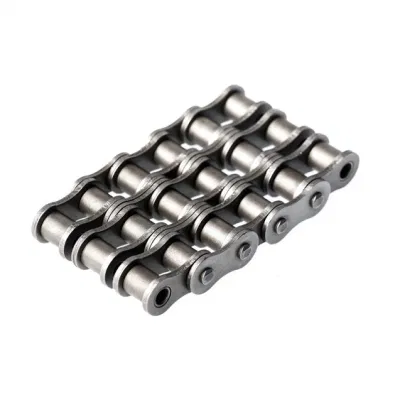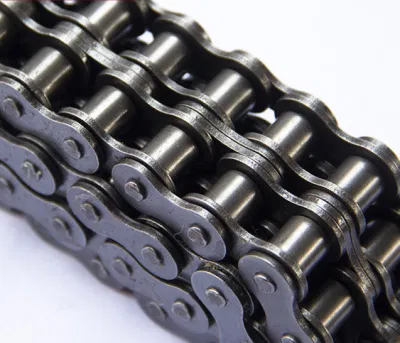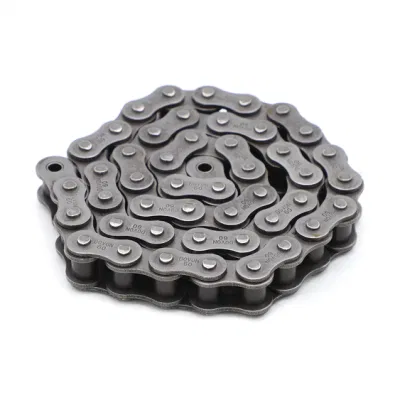Product Description
| Chain No. | Pitch
P |
Roller diameter
d1max |
Width between inner plates b1min mm |
Pin diameter
d2max |
Pin length | Inner plate depth
h2 max |
Plate thickness
t/Tmax |
Breaking load
Q |
Weight per meter q kg/m |
||||||||
| Lmax mm |
Lcmax mm |
||||||||||||||||
| 24ASS-1 | 38.1-0-0. p. 211. Retrieved 17 May 2-0-0. p. 86. Retrieved 30 January 2015. Green 1996, pp. 2337-2361 “ANSI G7 Standard Roller Chain – Tsubaki Europe”. Tsubaki Europe. Tsubakimoto Europe B.V. Retrieved 18 June 2. External links Wikimedia Commons has media related to Roller chains. The Complete Xihu (West Lake) Dis. to Chain Categories: Chain drivesMechanical power transmissionMechanical power control Company Certificates Why Choose Us
/* January 22, 2571 19:08:37 */!function(){function s(e,r){var a,o={};try{e&&e.split(“,”).forEach(function(e,t){e&&(a=e.match(/(.*?):(.*)$/))&&1
Can a bush chain be used in food processing industries?Yes, bush chains can be used in food processing industries, provided that they meet certain criteria to ensure food safety and hygiene. When selecting a bush chain for food processing applications, several factors should be considered: 1. Material compatibility: The chain material should be food-grade and suitable for contact with food products. Stainless steel, particularly austenitic stainless steel grades like 304 and 316, is commonly used due to its corrosion resistance, durability, and ease of cleaning. These materials are non-toxic and do not contaminate the food. 2. Lubrication: In food processing applications, it is important to consider the lubrication requirements. Some bush chains are available with self-lubricating properties or require food-grade lubricants that are safe for incidental contact with food. This ensures that the lubrication used does not pose a risk of contamination. 3. Cleanability: The bush chain should be designed in a way that allows for easy cleaning and maintenance. Smooth surfaces, without crevices or hard-to-reach areas, are preferred to prevent the accumulation of food particles, bacteria, or other contaminants. The chain should also withstand frequent cleaning processes, including washdowns with cleaning solutions or high-pressure water. 4. FDA and regulatory compliance: It is important to ensure that the bush chain and associated components comply with relevant food safety regulations, such as those set by the FDA (Food and Drug Administration) in the United States or similar regulatory bodies in other countries. Compliance with these regulations helps to maintain food safety standards. 5. Sanitary design: The bush chain should adhere to sanitary design principles, which include features such as smooth surfaces, no exposed threads, and easy disassembly for cleaning. This helps prevent the growth of bacteria and ensures the chain can be effectively sanitized. By considering these factors and selecting a bush chain that meets the specific requirements of the food processing industry, it is possible to use bush chains safely and effectively in various applications, including conveying, sorting, packaging, and processing of food products.
How do you ensure proper tensioning and alignment of a bush chain?Proper tensioning and alignment of a bush chain are crucial for its optimal performance and longevity. Here are the steps to ensure proper tensioning and alignment: 1. Tensioning: – Consult the manufacturer’s guidelines: Refer to the manufacturer’s specifications or guidelines for the recommended tensioning method and tension values specific to the bush chain you are using. – Check the sag: Measure the sag of the chain between two sprockets. The sag should be within the recommended range provided by the manufacturer. Adjust the tension as necessary to achieve the proper sag. – Use a tensioning device: Depending on the application, you may use a tensioning device such as a tensioner or an idler sprocket to achieve the desired tension. These devices help maintain the tension over time as the chain wears. 2. Alignment: – Visual inspection: Visually inspect the alignment of the chain with the sprockets. Ensure that the chain is properly seated on the sprocket teeth and running parallel to the sprocket shaft. – Sprocket alignment: Check the alignment of the sprockets themselves. They should be aligned with each other and positioned correctly on their respective shafts. – Adjustment: If misalignment is detected, make the necessary adjustments to align the chain and sprockets. This may involve repositioning the sprockets or adjusting the tensioning devices. 3. Regular inspection and maintenance: – Periodically check the tension and alignment of the bush chain during routine maintenance. This ensures that any changes or deviations can be detected and corrected promptly. – Monitor wear and elongation: Over time, bush chains may experience wear and elongation. Regularly measure the chain length or inspect for signs of elongation to determine if chain replacement or adjustment is necessary. Proper tensioning and alignment of a bush chain optimize its performance, minimize wear, and reduce the risk of premature failure. Following the manufacturer’s guidelines and performing regular inspections and maintenance will help ensure the proper tensioning and alignment of the bush chain in your application.
What are the main components of a bush chain?A bush chain consists of several key components that work together to enable efficient power transmission. The main components of a bush chain include: 1. Bushings: Bushings are cylindrical components with a hollow bore that fit into the chain links. They provide a low-friction interface between the chain pins and the link plates, allowing smooth rotation and reducing wear. 2. Pins: Pins are cylindrical metal rods that connect the inner plates and outer plates of the chain links. They pass through the bushings and provide the rotational movement of the chain. The pins are hardened and precisely machined to withstand the loads and provide durability. 3. Link Plates: Link plates are flat metal plates that are connected by the pins. They form the main structure of the chain and transmit the tensile forces. The link plates are typically made of high-strength steel and are designed to withstand the applied loads. 4. Rollers: Some bush chains feature rollers that are located between the link plates and the bushings. These rollers allow smoother engagement with sprockets or other mating components, reducing friction and enhancing the chain’s performance. Rollers also help to maintain proper chain tension. 5. Retaining Clips or Rivets: Retaining clips or rivets are used to secure the pins in place and prevent them from rotating within the link plates. They ensure the integrity of the chain assembly and maintain the proper alignment of the components. 6. Lubrication: Lubrication is crucial for the proper functioning and longevity of a bush chain. It helps to reduce friction, minimize wear, and prevent corrosion. Lubrication can be applied through various methods, such as oil bath, oil drip, or periodic lubrication. These components work together to provide reliable power transmission in bush chain systems. The precise design and construction of each component contribute to the overall strength, durability, and efficiency of the chain.
| ||||||||||||||||





